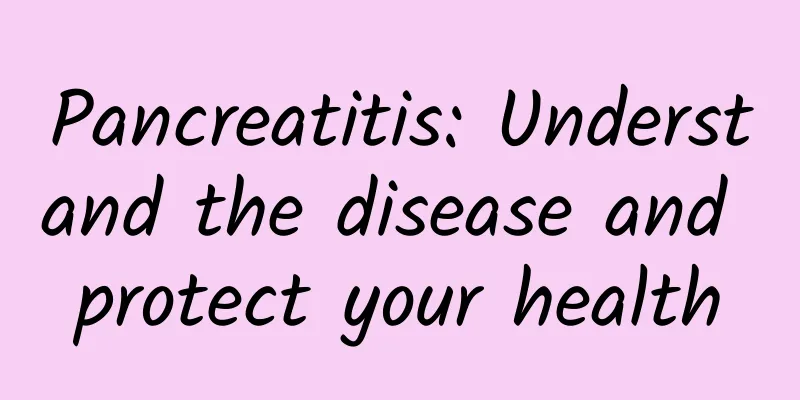Pancreatitis: Understand the disease and protect your health

|
Pancreatitis is a common but serious disease that can have a serious impact on our lives. Although the term may be unfamiliar to many people, the incidence of pancreatitis is increasing year by year. Understanding the causes, symptoms, treatments, and prevention measures of this disease is essential for our health. What causes pancreatitis? The pancreas is located in the upper left abdomen of the human body and is an important digestive organ. According to the severity, it can be divided into mild, moderate, severe and severe acute pancreatitis. This disease has an acute onset, develops rapidly, and is very dangerous. Acute pancreatitis is caused by improper diet. After overeating and drinking a lot of alcohol, the secretion of gastric acid increases, stimulating the secretion of pancreatic enzymes. In addition, alcohol can stimulate the duodenal mucosa, leading to edema of the duodenal papilla and hindering the excretion of pancreatic enzymes. Pancreatic enzymes are activated in large quantities in the pancreas, resulting in acute pancreatitis. Under normal circumstances, pancreatic juice contains inactive zymogen in its glandular tissue. Pancreatic juice continuously flows into the duodenum through the sphincter of Oddi along the pancreatic duct. Due to the presence of bile in the duodenum and the secretion of a kind of enterokinase by the duodenal wall mucosa, zymogen begins to transform into a very active digestive enzyme under the action of the two. If the outflow tract is blocked and excretion is not smooth, pancreatitis can be caused. The concept and causes of pancreatitis 1. Acute pancreatitis is an acute inflammation caused by the digestion of the pancreas and its surrounding tissues by pancreatic enzymes, and the main manifestations are edema, hemorrhage and necrosis of the pancreas. The causes of the disease are mostly as follows: (1) Biliary system diseases Biliary inflammation, stones, parasites, edema, spasm and other lesions cause obstruction in the ampulla, bile refluxes into the pancreatic duct through the common channel, activates pancreatic enzymes, and thus causes pancreatitis. (2) Excessive drinking and overeating Excessive drinking and overeating lead to vigorous secretion of pancreatic juice and poor drainage of the pancreatic duct, which increases the pressure of pancreatic juice in the pancreaticobiliary system, causing the excretion of high-concentration proteases to be impaired, and finally causes the rupture of pancreatic alveoli and the onset of the disease. (3) Surgery that damages the stomach, bile duct, or other abdominal surgery that squeezes the pancreas or causes excessive pressure in the pancreaticobiliary duct. (4) Infection: Many infectious diseases can cause acute pancreatitis, and the symptoms are often not obvious. For example, if roundworms enter the bile duct or pancreatic duct, they can bring in bacteria, which can activate pancreatic enzymes and cause pancreatic inflammation. (5) Hyperlipidemia and hypercalcemia In hyperlipidemia, fat embolism blocks the pancreatic blood vessels, causing local ischemia, capillary dilation, and damage to the blood vessel walls, leading to difficulty in excreting pancreatic juice; stones can block the pancreatic duct and cause pancreatitis. 2. Chronic pancreatitis A chronic, progressive destruction of the pancreas caused by repeated attacks of acute pancreatitis. Clinical manifestations of pancreatitis 1. Acute pancreatitis There is often a history of overeating or biliary disease before the onset of the disease. Acute pancreatitis can be divided into common type and hemorrhagic necrotic type. The hemorrhagic necrotic type is less common, but the condition is serious and the mortality rate is high. (1) Shock patients often have symptoms such as pallor, cold sweat, weak pulse, and decreased blood pressure. Shock can be caused by a variety of reasons, such as pancreatic fluid overflow, irritation of the peritoneum, severe pain; pancreatic tissue and intra-abdominal bleeding; tissue necrosis, body poisoning caused by protein decomposition, etc. Severe shock can be fatal if not promptly treated. (2) Abdominal pain. Abdominal pain is often located in the upper and middle abdomen, and sometimes radiates to the waist and back in a band-like manner. It can be relieved by bending over or leaning forward to sit. It often occurs suddenly after drinking a lot of alcohol or eating a full meal. The severity varies. Mild cases are dull pain, while severe cases are mostly persistent colic. (3) Nausea and vomiting. Most patients vomit gastric contents or even bile at the onset of the disease, and the abdominal pain does not ease after vomiting. (4) Fever. Most patients with acute pancreatitis experience moderate fever, which usually lasts for 3 to 5 days. (5) Patients with water, electrolyte and acid-base imbalances have varying degrees of dehydration. Frequent vomiting may lead to metabolic alkalosis. Severe pancreatitis is often accompanied by metabolic acidosis, hypocalcemia, increased blood sugar, hypokalemia and hypomagnesemia. 2. Chronic pancreatitis (1) Abdominal pain, mostly located in the upper abdomen, diffuse, and may radiate to the back and ribs, and is relieved by sitting up or leaning forward. (2) Pancreatic insufficiency, with varying degrees of indigestion symptoms such as abdominal distension, poor appetite, aversion to oil, weight loss, and steatorrhea; half of the patients develop diabetes due to endocrine dysfunction. (3) Physical signs. Mild chronic pancreatitis rarely has positive signs. Some cases have mild tenderness in the upper abdomen. Late-stage chronic pancreatitis may have symptoms of malnutrition due to steatorrhea. If it is an acute attack, moderate to severe tenderness in the upper abdomen may occur. How to avoid acute pancreatitis? 1. Treat biliary diseases, such as preventing biliary ascariasis, treating biliary stones, and avoiding acute attacks of biliary diseases. 2. Control drinking. People who drink excessively on weekdays suffer from malnutrition caused by chronic alcoholism, which damages the liver, pancreas and other organs, and reduces their ability to resist infection. On this basis, acute pancreatitis may be caused by excessive drinking, so not drinking a lot is also one of the prevention methods. 3. Avoid overeating. Eating a lot can cause gastrointestinal dysfunction, hinder the normal activity and emptying of the intestines, hinder the normal drainage of bile and pancreatic juice, and cause pancreatitis. 4. Avoid infection. Some infectious diseases can cause pancreatitis. The symptoms are usually not obvious. After the primary disease is cured, pancreatitis will disappear on its own. Common ones include mumps, viral hepatitis, etc. What are the home treatment measures? 1 Help the patient to lie in a supine position with legs bent and stomach relaxed. 2 Try to comfort the patient as much as possible to make him/her emotionally relaxed and calm, and reduce struggling, rolling and other activities. 3. It is not recommended to give the patient food, medicine, or water to avoid aggravating the condition. 4. When the pain is unbearable, do not rub your stomach, let alone take painkillers. Rubbing your stomach may spread or aggravate peritonitis, and taking painkillers will mask the symptoms of abdominal pain, making it more difficult for doctors to diagnose. 5. Call emergency number immediately and go to hospital for treatment. I hope this knowledge can help everyone pay more attention to their health, develop good eating habits, and stay away from diseases such as pancreatitis. Let us work together for health, so that in the new year we can pay more attention to our bodies, stay healthy, and welcome a better future! (Meng Ting, Lingshou County People's Hospital, Shijiazhuang City, Hebei Province) |
<<: The road to recovery from appendicitis: practical nursing can help you!
Recommend
To treat nerve damage, how long should methylcobalamin be taken and what should be paid attention to when taking the medication?
A friend who suffers from trigeminal neuralgia to...
A woman dreamed that one of her upper teeth fell out.
If our success is to be multi-faceted, it is not ...
What is the reason for a 40-year-old woman to have less menstrual flow?
Small menstrual flow is an abnormal symptom. Unde...
What should women do if they urinate frequently after drinking water?
Generally speaking, the amount of urine will incr...
What are the reactions during the 4th to 5th day of pregnancy?
Many pregnant women will show many symptoms durin...
What should I do if the wardrobe near the bathroom is moldy? What should I do if the wardrobe near the bathroom is moldy?
We all know that when decorating a house, many pl...
Vaginitis with fungal infection subsides as soon as the medication is stopped
Vaginitis has also become a genital disease with ...
Which should be added first when cooking, salt or sugar? What is the role of adding salt or sugar when cooking?
We all know that cooking is very particular, espe...
Is microwave treatment good for cervical erosion?
There are several treatments for cervical erosion...
Treatment of chronic vulvar dystrophy
As for the symptoms of vulvar malnutrition, I bel...
What medicine should I take for endometrial thickening?
Endometrial thickening is a common interstitial h...
Will eating lychees cause "lychee disease"? In fact, eating lychees this way is more "safe"
There are N+1 reasons to fall in love with summer...
Brown bleeding without abdominal pain in mid-pregnancy
During pregnancy, no matter what kind of problems...
The consequences of a woman's fallopian tube removal
In fact, if women do not consider having children...









